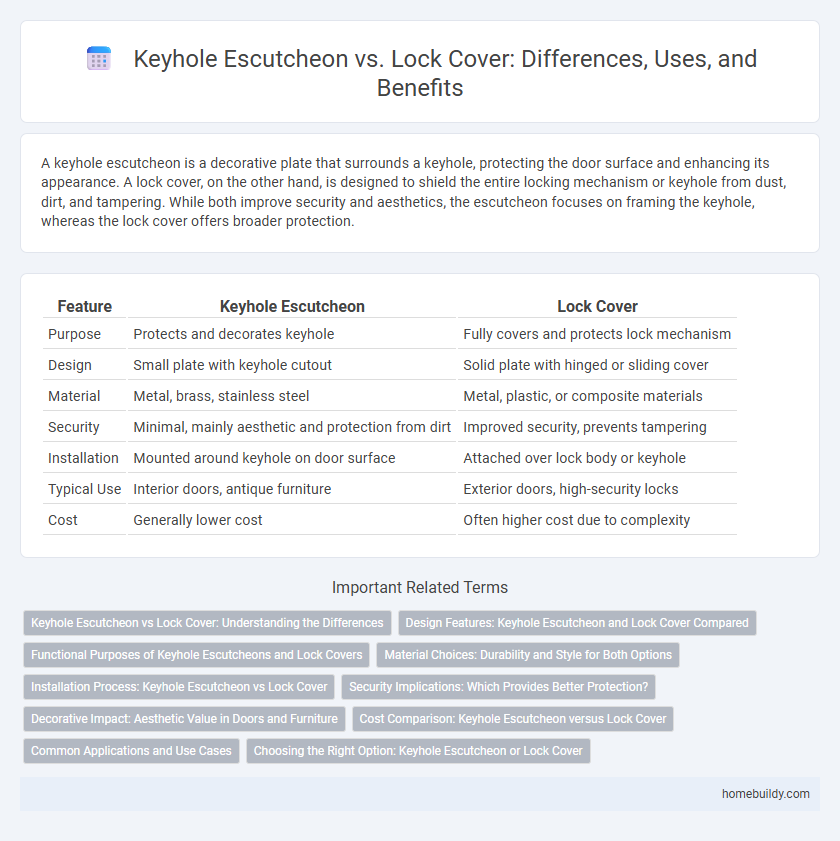A keyhole escutcheon is a decorative plate that surrounds a keyhole, protecting the door surface and enhancing its appearance. A lock cover, on the other hand, is designed to shield the entire locking mechanism or keyhole from dust, dirt, and tampering. While both improve security and aesthetics, the escutcheon focuses on framing the keyhole, whereas the lock cover offers broader protection.
Table of Comparison
| Feature | Keyhole Escutcheon | Lock Cover |
|---|---|---|
| Purpose | Protects and decorates keyhole | Fully covers and protects lock mechanism |
| Design | Small plate with keyhole cutout | Solid plate with hinged or sliding cover |
| Material | Metal, brass, stainless steel | Metal, plastic, or composite materials |
| Security | Minimal, mainly aesthetic and protection from dirt | Improved security, prevents tampering |
| Installation | Mounted around keyhole on door surface | Attached over lock body or keyhole |
| Typical Use | Interior doors, antique furniture | Exterior doors, high-security locks |
| Cost | Generally lower cost | Often higher cost due to complexity |
Keyhole Escutcheon vs Lock Cover: Understanding the Differences
Keyhole escutcheons provide a decorative and protective plate around a keyhole, enhancing door aesthetics while preventing wear and tampering. Lock covers, on the other hand, are designed primarily to shield the lock mechanism from dust, dirt, and weather exposure, offering functional protection without emphasizing decorative elements. Understanding these differences helps in selecting the right hardware for security, style, and maintenance needs.
Design Features: Keyhole Escutcheon and Lock Cover Compared
Keyhole escutcheons feature a slim, decorative plate specifically designed to outline and protect the keyhole, often emphasizing aesthetic appeal with intricate detailing suitable for traditional or vintage doors. Lock covers provide full coverage over the lock mechanism, offering enhanced security and protection from dirt or tampering, typically with a more utilitarian and robust design. The keyhole escutcheon prioritizes elegant exposure of the keyhole, while lock covers emphasize functional protection, influencing material choice and overall design style.
Functional Purposes of Keyhole Escutcheons and Lock Covers
Keyhole escutcheons primarily serve to protect and reinforce the keyhole area while providing an aesthetic frame that enhances door design. Lock covers function to shield the entire locking mechanism from dust, dirt, and tampering, offering comprehensive protection beyond the keyhole itself. Both components contribute to security, but keyhole escutcheons emphasize decorative reinforcement whereas lock covers prioritize mechanical safeguarding.
Material Choices: Durability and Style for Both Options
Keyhole escutcheons and lock covers differ significantly in material choices, affecting durability and style; escutcheons commonly use brass, stainless steel, or bronze for corrosion resistance and classic aesthetics, while lock covers often feature steel or plastic for enhanced security and cost-efficiency. Brass keyhole escutcheons offer a traditional look with long-lasting wear, whereas steel lock covers provide robust protection against tampering but may lack decorative appeal. Selecting between these options depends on balancing material strength with desired visual impact in architectural hardware applications.
Installation Process: Keyhole Escutcheon vs Lock Cover
The installation process of a keyhole escutcheon involves precise alignment over the keyhole to ensure smooth key access, typically requiring screws or adhesive for secure attachment. In contrast, a lock cover installation generally demands more intricate fitting around the lock cylinder, often including additional components for enhanced protection against tampering. Keyhole escutcheons usually offer quicker, less complex installation compared to the more robust and secure mounting process associated with lock covers.
Security Implications: Which Provides Better Protection?
Keyhole escutcheons offer precise cutouts that allow key access while limiting exposure to lock mechanisms, enhancing security against tampering and picking. Lock covers provide a solid barrier, often incorporating weather-resistant materials that prevent dust and moisture intrusion but may be easier to remove or bypass physically. For optimized protection, keyhole escutcheons deliver superior defense by balancing accessibility with resistance to forced entry and lock manipulation.
Decorative Impact: Aesthetic Value in Doors and Furniture
Keyhole escutcheons enhance the aesthetic value of doors and furniture by adding intricate decorative details that highlight craftsmanship and design elegance. Unlike lock covers, which primarily focus on security and functionality, keyhole escutcheons serve as ornamental accents that complement various architectural styles and interior decor themes. Their presence elevates the visual appeal while subtly framing the keyhole, making them a preferred choice for enhancing decorative impact.
Cost Comparison: Keyhole Escutcheon versus Lock Cover
Keyhole escutcheons generally offer a more cost-effective solution compared to lock covers, primarily due to simpler manufacturing processes and less material usage. Lock covers, often made from heavier materials and featuring more complex designs for added protection, tend to incur higher production and installation costs. When budgeting for door hardware, keyhole escutcheons provide affordability while maintaining essential functionality and aesthetic appeal.
Common Applications and Use Cases
Keyhole escutcheons are commonly used in residential and commercial furniture to provide a decorative and protective frame around keyholes, ensuring smooth key insertion while maintaining aesthetic appeal. Lock covers primarily serve in security applications by concealing locks to prevent tampering and unauthorized access, often found in industrial or high-security environments. While keyhole escutcheons balance functionality and design in cabinetry and door hardware, lock covers focus on enhancing security in sensitive or exposed locking mechanisms.
Choosing the Right Option: Keyhole Escutcheon or Lock Cover
Keyhole escutcheons provide precise alignment and aesthetic enhancement around the keyhole, making them ideal for traditional doors and furniture with visible lock mechanisms. Lock covers offer comprehensive protection against dirt and tampering, suitable for exterior doors or high-security settings where durability is essential. Selecting between a keyhole escutcheon and a lock cover depends on balancing decorative appeal with functional security requirements.
Keyhole escutcheon vs Lock cover Infographic

 homebuildy.com
homebuildy.com